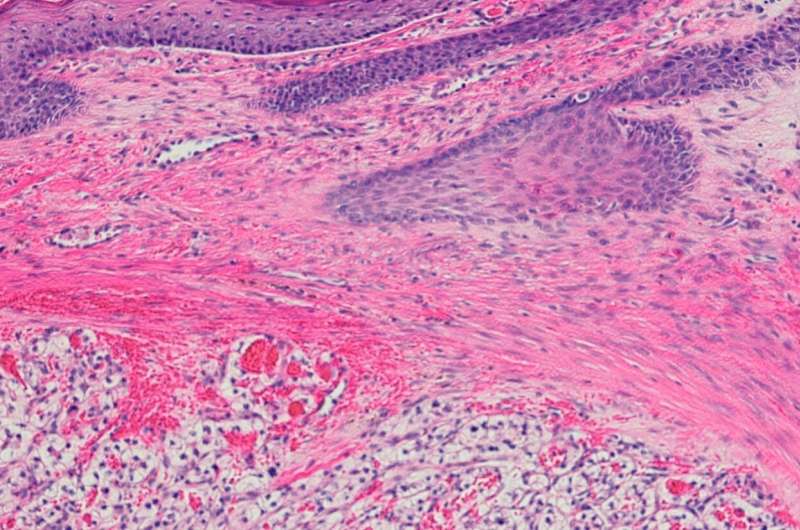This article has been reviewed according to Science X's editorial process and policies. Editors have highlighted the following attributes while ensuring the content's credibility:
fact-checked
trusted source
proofread
Mathematics supporting fresh theoretical approach in oncology

A study by the University of the Basque Country (UPV/EHU) uses game theory to establish that tumors with less cellular heterogeneity are more aggressive
Mathematics, histopathology, and genomics converge to confirm that the most aggressive clear cell renal cell carcinomas display low levels of intratumor heterogeneity, i.e., they contain fewer distinct cell types. The study, conducted by the UPV/EHU Ikerbasque Research Professor Annick Laruelle, supports the hypothesis that it would be advisable to apply therapeutic strategies to maintain high levels of cellular heterogeneity within the tumor in order to slow down the evolution of the cancer and improve survival.
Mathematical approaches are gaining traction in modern oncology as they provide fresh knowledge about the evolution of cancer and new opportunities for therapeutic improvement. So, data obtained from mathematical analyses endorse many of the histological findings and genomic results.
Game theory, for example, helps to understand the "social" interactions that occur between cancer cells. This novel perspective allows the scientific and clinical community to understand the hidden events driving the disease. In actual fact, considering a tumor as a collectivity of individuals governed by rules previously defined in ecology opens up new therapeutic possibilities for patients.
Within the framework of game theory, the hawk-dove game is a mathematical tool developed to analyze cooperation and competition in biology. When applied to cancer cell collectivities, it explains the possible behaviors of tumor cells when competing for an external resource.
"It is a decision theory in which the outcome does not depend on one's own decision alone, but also on the decision of the other actors," explained Ikerbasque Research Professor Annick Laruelle, an expert in game theory in the UPV/EHU's Department of Economic Analysis. "In the game, cells may act aggressively, like a hawk, or passively, like a dove, to acquire a resource."
Professor Laruelle has used this game to analyze bilateral cell interactions in highly aggressive clear cell renal cell carcinoma in two different scenarios: one involving low tumor heterogeneity, when only two tumor cell types compete for a resource; and the other, high tumor heterogeneity, when such competition occurs between three tumor cell types.
Clear cell renal cell carcinoma is so named because the tumor cells appear clear, like bubbles, under the microscope. This type of carcinoma has been taken as a representative case for the study, as it is a widely studied paradigm of intratumor heterogeneity (which refers to the coexistence of different subpopulations of cells within the same tumor).
Fresh theoretical approach for new therapeutic strategies
Laruelle has thus shown how some of the fundamentals of intratumor heterogeneity, corroborated from the standpoint of histopathology and genomics, are supported by mathematics using the hawk-dove game. The work, carried out in collaboration with researchers from Biocruces, the San Giovanni Bosco Hospital in Turin (Italy), and the Pontificia Universidade Catolica do Rio de Janeiro, has been published in the journal Trends in Cancer.
The group of researchers believes that "this convergence of findings obtained from very different disciplines reinforces the key role of translational research in modern medicine and gives intratumor heterogeneity a key position in the approach to new therapeutic strategies," and they conjecture that "intratumor heterogeneity behaves by following similar pathways in many other tumors."
This may have important practical implications for the clinical management of malignant tumors. The constant arrival of new molecules enriches cancer treatment opportunities in the era of precision oncology. However, the researchers say, "it is one thing to discover a new molecule and quite another to find the best strategy for using it. So far, the proposed approach is based on administering the maximum tolerable dose to the patient. However, this strategy forces the tumor cells to develop resistance as early as possible, thus transforming the original tumor into a neoplasm of low intratumor heterogeneity comprising only resistant cells."
So, a therapy specifically aimed at preserving high intratumor heterogeneity may make sense according to this theoretical approach, as it may slow cancer growth and thus lead to longer survivals. This perspective is currently gaining interest in oncology.
More information: Claudia Manini et al, Convergent insights into intratumor heterogeneity, Trends in Cancer (2023). DOI: 10.1016/j.trecan.2023.08.009





















